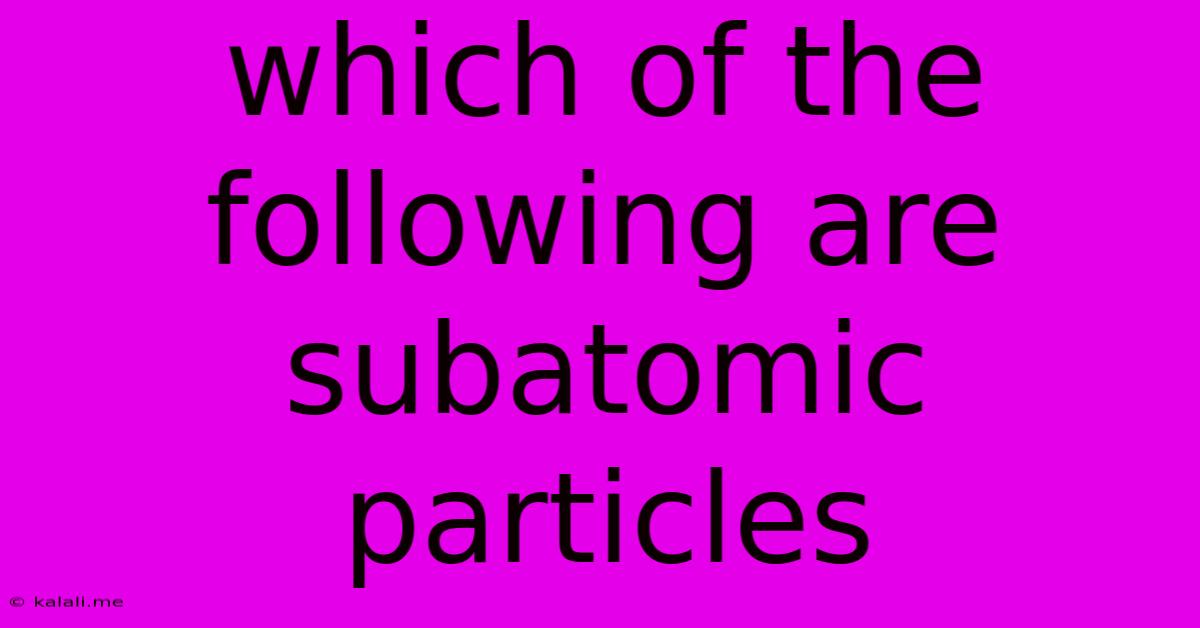Which Of The Following Are Subatomic Particles
Kalali
Jun 12, 2025 · 3 min read

Table of Contents
Which of the Following Are Subatomic Particles? A Comprehensive Guide
This article explores the fascinating world of subatomic particles, explaining what they are and clarifying which particles from a given list would qualify. Understanding subatomic particles is crucial for grasping the fundamental building blocks of matter and the forces that govern the universe. We'll delve into the different categories of subatomic particles and provide examples to solidify your understanding.
What are Subatomic Particles?
Subatomic particles are particles that are smaller than an atom. Atoms, the basic units of chemical elements, are composed of a nucleus containing protons and neutrons, surrounded by a cloud of electrons. These protons, neutrons, and electrons are the most commonly known subatomic particles, but many more exist. The field of particle physics delves into the incredibly tiny world beyond these fundamental components, revealing a complex and intricate structure.
Categories of Subatomic Particles
Subatomic particles can be broadly categorized into several groups:
-
Fundamental Particles: These are particles that are not made up of smaller constituents. They are considered elementary particles and are the building blocks of all other matter. The Standard Model of particle physics describes these fundamental particles.
-
Hadrons: These are composite particles made up of quarks held together by the strong nuclear force. Protons and neutrons are examples of hadrons.
-
Leptons: These are fundamental particles that do not experience the strong nuclear force. Electrons, muons, and tau particles are examples of leptons.
-
Bosons: These particles mediate the fundamental forces of nature. Photons (electromagnetic force), gluons (strong force), W and Z bosons (weak force), and the Higgs boson (gives mass to other particles) are examples of bosons.
Identifying Subatomic Particles from a List
To determine if a particle is subatomic, consider these characteristics:
- Size: It must be smaller than an atom.
- Composition: It might be a fundamental particle or a composite particle made of other subatomic particles.
- Role in the atom: It may be a constituent of an atom's nucleus or exist within the electron cloud.
- Interaction with forces: It interacts with fundamental forces like the electromagnetic, strong, or weak force.
Without a specific list provided, it's impossible to definitively say which particles are subatomic. However, using the information above, you can readily identify any particle listed as a subatomic particle. For example:
- Electrons: Definitely subatomic. They are fundamental leptons and orbit the nucleus of an atom.
- Protons: Subatomic. They are composite hadrons found in the atomic nucleus.
- Neutrons: Subatomic. Composite hadrons found in the atomic nucleus (except in hydrogen-1).
- Quarks: Subatomic. Fundamental particles that make up hadrons like protons and neutrons.
- Gluons: Subatomic. Fundamental bosons that mediate the strong force.
- Photons: Subatomic. Fundamental bosons that mediate the electromagnetic force.
Beyond the Basics: Exploring the World of Particle Physics
The study of subatomic particles is an ongoing endeavor. New discoveries are constantly expanding our understanding of the universe's fundamental building blocks and their interactions. This field is complex, but the fundamental concepts outlined here provide a strong foundation for further exploration. By understanding the categories and characteristics of subatomic particles, you can confidently determine whether any given particle qualifies as a subatomic particle. Remember to consider size, composition, role in the atom, and interaction with fundamental forces.
Latest Posts
Latest Posts
-
Which Of The Following Is An Observation
Jun 13, 2025
-
Find The Radius Of Convergence Calculator
Jun 13, 2025
-
Specific Weight Of Water In Si Unit
Jun 13, 2025
-
Memorandum Of Agreement Vs Memorandum Of Understanding
Jun 13, 2025
-
Least Common Multiple Of 27 And 45
Jun 13, 2025
Related Post
Thank you for visiting our website which covers about Which Of The Following Are Subatomic Particles . We hope the information provided has been useful to you. Feel free to contact us if you have any questions or need further assistance. See you next time and don't miss to bookmark.